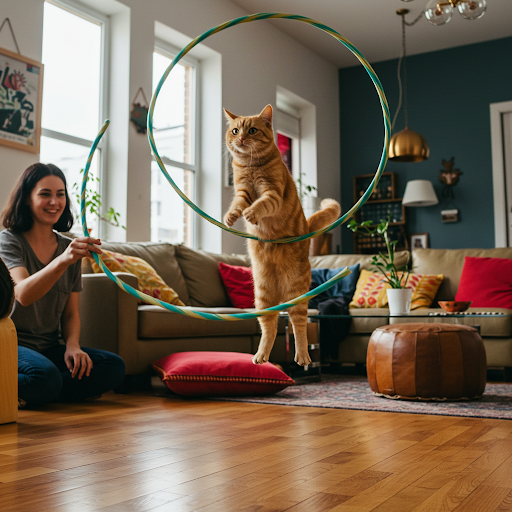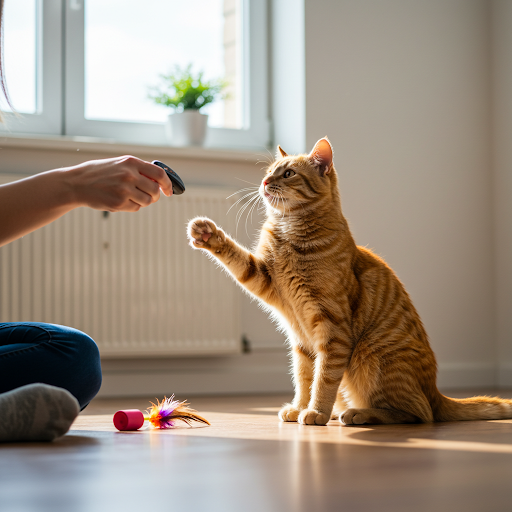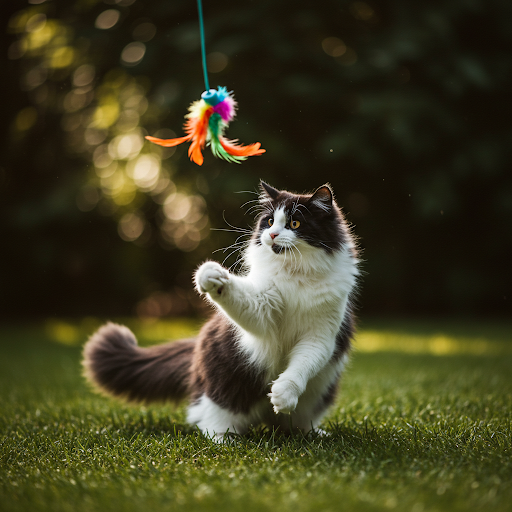Did you know that cats can be trained just as well as dogs? That’s right! While the popular belief is that cats are aloof and independent, often ignoring human commands, the truth is they can learn and respond to training. Let’s dive into real methods that have helped millions of cat owners engage and train their feline friends.
We live in an era where those who miss the opportunity to train their cats are tagging behind in the pet parenting world. According to the latest statistics, 85% of cat owners report improved behavior with consistent training.
The Science of Cat Training: Myth-Busting Facts

Cats have long been stereotyped as untrainable, but the scientific truth is quite different. Cats possess a strong ability to learn through positive reinforcement. According to a study published in the Journal of Veterinary Behavior, cats learn new tricks as effectively as dogs when they are encouraged with treats and praise.
The notion that cats cannot be trained stems largely from their independent nature. Yet, much like any other animal, with the right motivation – usually food – cats eagerly participate in training sessions.
Our feline friends are intelligent beings with memory formations similar to two-year-old children, meaning they can remember and associate actions with outcomes.
Why Train Your Cat: Benefits Beyond Behavior

Training your cat goes beyond just teaching new tricks. It strengthens the bond between you and your feline companion. A well-trained cat is often more social, engaging, and adaptable to new situations and people.
A trained cat is also less likely to develop behavioral issues such as aggression or excessive shyness. As with humans, learning is an exercise that keeps their brain active, reducing the likelihood of cognitive decline as they age.
Moreover, according to surveys, trained cats tend to face fewer health issues associated with stress, such as obesity and diabetes, indicating that mental stimulation contributes to physical well-being.
Getting Started: Setting the Stage for Success

The first step in cat training is understanding your cat’s individual personality and preferences. Some cats are motivated by treats, while others may respond better to affection or playtime.
Create a positive environment without distractions, where your cat feels safe and secure. Training should be a fun and rewarding experience for both of you, not a chore.
Start by choosing specific behaviors you want to teach or correct. Keep sessions short and sweet — cats have short attention spans, and overtraining can lead to disinterest.
The Power of Positive Reinforcement

Positive reinforcement is the cornerstone of effective cat training. This means rewarding your cat for the behavior you want to encourage. Treats, affectionate petting, or extra playtime can serve as effective rewards.
For instance, if you want to train your cat to sit, use a treat to guide its nose upward, encouraging its bottom to touch the ground. As soon as it sits, reward it immediately. Consistency and timing are keys in creating a strong association between the behavior and the reward.
Studies have shown that punishment is generally ineffective in training cats and can lead to fear and anxiety, making positive reinforcement the go-to method.
Clicker Training: Is It Worth the Hype?

Clicker training, popular among dog trainers, is also gaining traction with cats. The concept is simple: the click sound marks the desired behavior, followed by a reward.
Research indicates that clicker training is particularly effective for cats due to their strong auditory senses. By associating the click with rewards, they quickly learn the desired behavior.
If you’re considering clicker training, try using it during meal times to build a strong association between the click and positive outcomes, enhancing your cat’s learning speed.
Teaching Basic Commands: Where to Begin?

Basic commands such as ‘sit’, ‘come’, and ‘paw’ are achievable goals for your cat. Begin with the ‘sit’ command, often one of the easiest to master.
Use a treat to guide your cat’s movements while repeating the word ‘sit’. With repetition and rewards, your cat will associate the word with the action.
The ‘come’ command is especially useful. Captivate your cat’s attention with a favorite toy or treat, then use its name followed by ‘come’. Make the training a game—cats love games!
Desensitizing to Unfamiliar Sounds and Scenarios

Cats often fear unfamiliar sounds and situations, leading to stress. Training them to become desensitized is crucial for their emotional well-being.
Introduce your cat to new sounds, starting with low volumes. Gradually increase the volume, rewarding calm behavior with treats.
This method requires patience, but over time, your cat will learn to remain calm, whether during thunderstorms or loud household activities, enhancing their adaptability.
Turning Playtime into a Learning Opportunity

Cats love to play, and playtime can double as a training exercise. Utilize toys to encourage desired behaviors and reinforce training objectives.
For example, engage your cat in a friendly game of fetch using their favorite toy. Teach them to retrieve and return the toy by luring them with treats.
Interactive toys like puzzle feeders also stimulate their mental faculties while reinforcing positive behavior, combining play with practical training benefits.
Addressing Common Behavioral Issues

Behavioral issues such as scratching furniture or excessive meowing can often be resolved through targeted training strategies.
For scratching, provide appropriate alternatives like scratching posts, rewarding your cat for using them, while discouraging inappropriate locations.
To reduce excessive meowing, observe the triggers. Often, it’s a bid for attention or food. Train your cat to ‘speak’ or ‘quiet’ on command, reinforcing these commands with rewards.
Enhancing Your Cat’s Social Skills

Socializing your cat is crucial, particularly if they will interact with other pets or humans. Start by introducing new experiences gradually.
Expose your cat to new environments and people in a controlled manner, using treats and toys to create positive associations.
This training ensures your cat remains friendly and adaptable, which is particularly important in multi-pet households or during social gatherings.
Keeping Track of Progress: Tools and Techniques

Documenting your training sessions helps track progress and identify areas needing improvement. Consider maintaining a training journal or using apps designed for pet training.
These tools can help you monitor behavioral changes and adapt training techniques to meet your cat’s specific needs, ensuring ongoing development and success.
Keeping Up the Momentum: Avoid Training Pitfalls

Training isn’t a one-time activity; it requires consistent effort. Avoid common mistakes like inconsistent commands or infrequent training sessions.
If progress stalls, reassess your methods. Cat training is an evolving process, often requiring adaptations as your cat grows and changes.
Remember, patience is a vital element of successful cat training. Stay committed, and you’ll see lasting results.
Creating a Supportive Environment for Lifelong Learning

Learning doesn’t stop once your cat masters a few tricks. Maintain an environment full of stimuli to encourage continuous growth.
Rotate toys, introduce new challenges, and keep things interesting to prevent boredom, ensuring your cat remains engaged and entertained.
Closing Thoughts: Celebrating Success and Continuing the Journey

Training your cat not only improves behavior but also deepens your relationship. Celebrate each success, no matter how small, as a step towards a more harmonious home.
Keep experimenting, learning, and most importantly, enjoying the journey with your feline friend. The bond you create will last a lifetime, providing countless memories and mutual joy.
Now it’s time for you to share your experiences and tips in the comments. What’s your cat’s most impressive trick?

